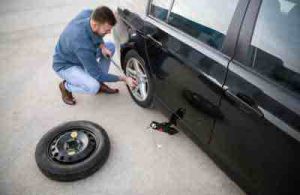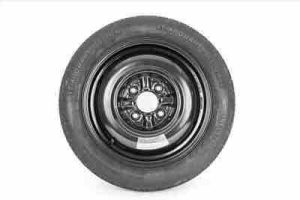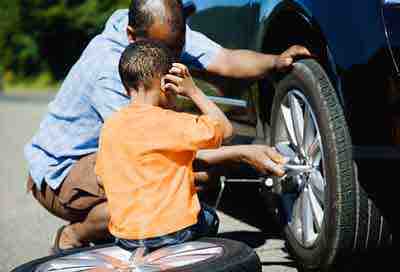You can drive on spare tires but not for too long. Spare tires by their nature are meant to be emergency alternatives for when the tire that came with your vehicle experiences a flat.
Have you seen a neighbor or maybe a friend with a spare tire on their running for days? Perhaps they didn’t have the time to change it?
Driving on a spare tire for too long can lead to the wear out of other useful car tires, weakened car transmission, undue wear and tears of the car parts, and eventual accidents or loss of life.
People drive on car spare or donut tires, but not for too long. I have driven on a spare tire for 40 miles at a speed of 60mph, but not more. You can try that too, but you shouldn’t exceed 40 miles at a speed of 60mph.
Table of Contents
What happens if you drive on a spare for too long (Explained)?

If you are driving on a regular-sized tire, you have nothing to fear. But if you are driving on a space saver, the following are the dangers and problems you would experience:
The spare wears out the other tires inappropriately
If you are driving on a space saver, you’d have noticed how it handles strangely on the road. You can feel the imbalance in the steering wheel.
The car tilts towards the spare tire, making the other tire treads improperly. This wear occurs unequally with time.
The other tires are carrying most of the weight of the car, the spare doesn’t contact the road completely.
Weakened transmission
The transmission is the mechanism in vehicles that transfers power from the engine to the wheels.
Whether your transmission is automatic or manual, using a spare tire that is smaller than the rest of your tires has a degrading effect on your transmission, weakening it.
It is the transmission that helps the vehicle slow down or speed, but with a smaller spare on one of the drive wheels, for instance, the process becomes conflicted since the spare lacks proper grip on the pavement.
Your braking and turning are skewed. When this happens too many times with the presence of the smaller spare, it damages the transmission of the vehicle.
Risk of accidents
Small spare tire means less traction, accumulation of ineffective transmission activity, an accident is not far off.
One other reason spare tires cause instability on the road is that they have thinner treads than regular tires.
With such a low tread quality you risk slipping off a wet road, a blowout if the tire is punctured, your life, and that of those in the car with you.
Undue wear and stress on the differential on the axle
The differential is the system of gears that allows different drive wheels, that is, the wheels that receive power from the engine.
This allows tires on the same axle to rotate at different speeds, like when a car is turning left or right.
So, if you are driving a space saver (on the wheel drive) which is a significantly smaller tire than the others, it spins faster than the other tire, causing stress on the differential of the tires.
This poses long-term problems for your vehicle.
The spare tire is not spared
Heat kills tires. The hotter they get the worse for them. The faster they spin the hotter they get. Space saver spares have less tread, for this reason, they spin faster than regular tires.
This means they are usually hotter and don’t cool quickly either. This opens doors for troubles like blowouts while the vehicle is in motion.
A little prick from a nail on the road and the tire explodes. Hence, driving a spare tire for too long is all too dangerous.
More gas per mileage, uneconomical
With a spare tire that is not the same size as the prime sets of your car, your speed drops significantly. Manufacturers of donut tires usually specify a low speed of 50 mph.
Your journeys will be slower even though the tire is spinning fast below. You have to take off ramps slower, drive in the slow lane, take slow turns off highways.
You spend more on gas but less mileage.
Finally, the spare tire’s integrity will fail eventually and cause you harm if you continue to drive it because it is lighter, smaller, and designed for short-term use alone.
Driving on a spare tire: for how long?

Heavens bless the man who invented spare tires. We hope he got an award for such a life-saving invention.
Now every car – well not some new models now – enjoys the benefit of spare tires.
As a simple rule, you should drive no more than 70 miles and not faster than 50 mph.
As we have established, you should not drive more than than 50mph on a spare tire, especially if you are using a space saver or a donut spare tire.
These are typically smaller than the rest of the tire on the car.
You should replace your spare with a proper sized tire shortly after. You can’t have your spare on indefinitely, it would serve its purpose then, and later on. Which is what spares are originally made for.
To answer the question the umpteenth, simple time, the type and quality of the spare in your car helps you decide how long you can drive on your spare.
Is the spare in your car the same size as the other tires? Or is it smaller, a space saver? For obvious reasons, a spare tire of the same size can stay on longer than a smaller one.
Final thoughts
Spare tires are essentials that come with vehicles, cars, light trucks, light trucks. And they come in different sizes too, and in two major types.
Big trucks have spares that match the sizes of the other tires, so do smaller cars too. Hence, you can’t switch spares between a car and a light truck.
The sight of it would really be awkward, and the result, disastrous.
There are two types of spares:
- The spares that are the same size as the other tires on the vehicle. These spares were the type you found in older model cars.
- Space Saver spare tires. Or the ones commonly called Donut tires. These tires are smaller than the normal tires on the car. They usually come with newer model cars.
Related topics:
- Do You Need A Torque Wrench to Change Tires
- Can You Patch A Tire After Using Fix-a-Flat
- Can A Pothole Cause a Flat Tire

